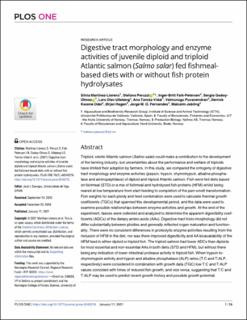| dc.contributor.author | Martinez-Llorens, Silvia | |
| dc.contributor.author | Peruzzi, Stefano | |
| dc.contributor.author | Falk-Petersen, Inger-Britt | |
| dc.contributor.author | Godoy-Olmos, Sergio | |
| dc.contributor.author | Ulleberg, Lars Olav | |
| dc.contributor.author | Tomas-Vidal, Ana | |
| dc.contributor.author | Puvanendran, Velmurugu | |
| dc.contributor.author | Odei, Derrick Kwame | |
| dc.contributor.author | Hagen, Ørjan | |
| dc.contributor.author | Fernandes, Jorge Manuel de Oliveira | |
| dc.contributor.author | Jobling, Malcolm | |
| dc.date.accessioned | 2021-04-28T13:14:03Z | |
| dc.date.available | 2021-04-28T13:14:03Z | |
| dc.date.created | 2021-01-12T09:17:15Z | |
| dc.date.issued | 2021 | |
| dc.identifier.citation | Martinez-Llorens, S., Peruzzi, S., Falk-Petersen, I.-B., Godoy-Olmos, S., Ulleberg, L. O., Tomas-Vidal, A., Puvanendran, V., Odei, D. K., Hagen, Ø., Fernandes, J. M. O. & Jobling, M. (2021). Digestive tract morphology and enzyme activities of juvenile diploid and triploid Atlantic salmon (Salmo salar) fed fishmealbased diets with or without fish protein hydrolysates. PLOS ONE, 16(1): e0245216. doi: | en_US |
| dc.identifier.issn | 1932-6203 | |
| dc.identifier.uri | https://hdl.handle.net/11250/2740206 | |
| dc.description.abstract | Triploid, sterile Atlantic salmon (Salmo salar) could make a contribution to the development of the farming industry, but uncertainties about the performance and welfare of triploids have limited their adoption by farmers. In this study, we compared the ontogeny of digestive tract morphology and enzyme activities (pepsin, trypsin, chymotrypsin, alkaline phosphatase and aminopeptidase) of diploid and triploid Atlantic salmon. Fish were fed diets based on fishmeal (STD) or a mix of fishmeal and hydrolysed fish proteins (HFM) whilst being reared at low temperature from start-feeding to completion of the parr-smolt transformation. Fish weights for each ploidy and feed combination were used to calculate thermal growth coefficients (TGCs) that spanned this developmental period, and the data were used to examine possible relationships between enzyme activities and growth. At the end of the experiment, faeces were collected and analyzed to determine the apparent digestibility coefficients (ADCs) of the dietary amino acids (AAs). Digestive tract histo-morphology did not differ substantially between ploidies and generally reflected organ maturation and functionality. There were no consistent differences in proteolytic enzyme activities resulting from the inclusion of HFM in the diet, nor was there improved digestibility and AA bioavailability of the HFM feed in either diploid or triploid fish. The triploid salmon had lower ADCs than diploids for most essential and non-essential AAs in both diets (STD and HFM), but without there being any indication of lower intestinal protease activity in triploid fish. When trypsin-tochymotrypsin activity and trypsin and alkaline phosphatase (ALP) ratios (T:C and T:ALP, respectively) were considered in combination with growth data (TGC) low T:C and T:ALP values coincided with times of reduced fish growth, and vice versa, suggesting that T:C and T:ALP may be used to predict recent growth history and possible growth potential. | en_US |
| dc.language.iso | eng | en_US |
| dc.publisher | PLOS | en_US |
| dc.relation.uri | https://journals.plos.org/plosone/article?id=10.1371/journal.pone.0245216 | |
| dc.rights | Navngivelse 4.0 Internasjonal | * |
| dc.rights.uri | http://creativecommons.org/licenses/by/4.0/deed.no | * |
| dc.title | Digestive tract morphology and enzyme activities of juvenile diploid and triploid Atlantic salmon (Salmo salar) fed fishmealbased diets with or without fish protein hydrolysates | en_US |
| dc.type | Peer reviewed | en_US |
| dc.type | Journal article | en_US |
| dc.description.version | publishedVersion | en_US |
| dc.rights.holder | © 2021 The Author(s) | en_US |
| dc.subject.nsi | VDP::Landbruks- og Fiskerifag: 900::Fiskerifag: 920::Akvakultur: 922 | en_US |
| dc.subject.nsi | VDP::Matematikk og Naturvitenskap: 400::Basale biofag: 470::Molekylærbiologi: 473 | en_US |
| dc.source.pagenumber | 28 | en_US |
| dc.source.volume | 16 | en_US |
| dc.source.journal | PLOS ONE | en_US |
| dc.source.issue | 1 | en_US |
| dc.identifier.doi | 10.1371/journal.pone.0245216 | |
| dc.identifier.cristin | 1869542 | |
| dc.relation.project | The Norwegian Research Council: 248028 | en_US |
| dc.source.articlenumber | e0245216 | en_US |

